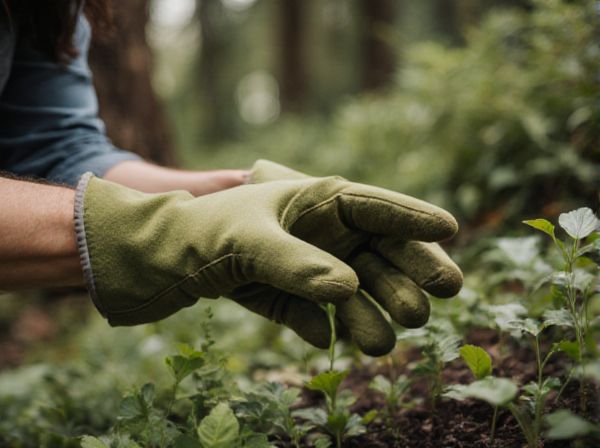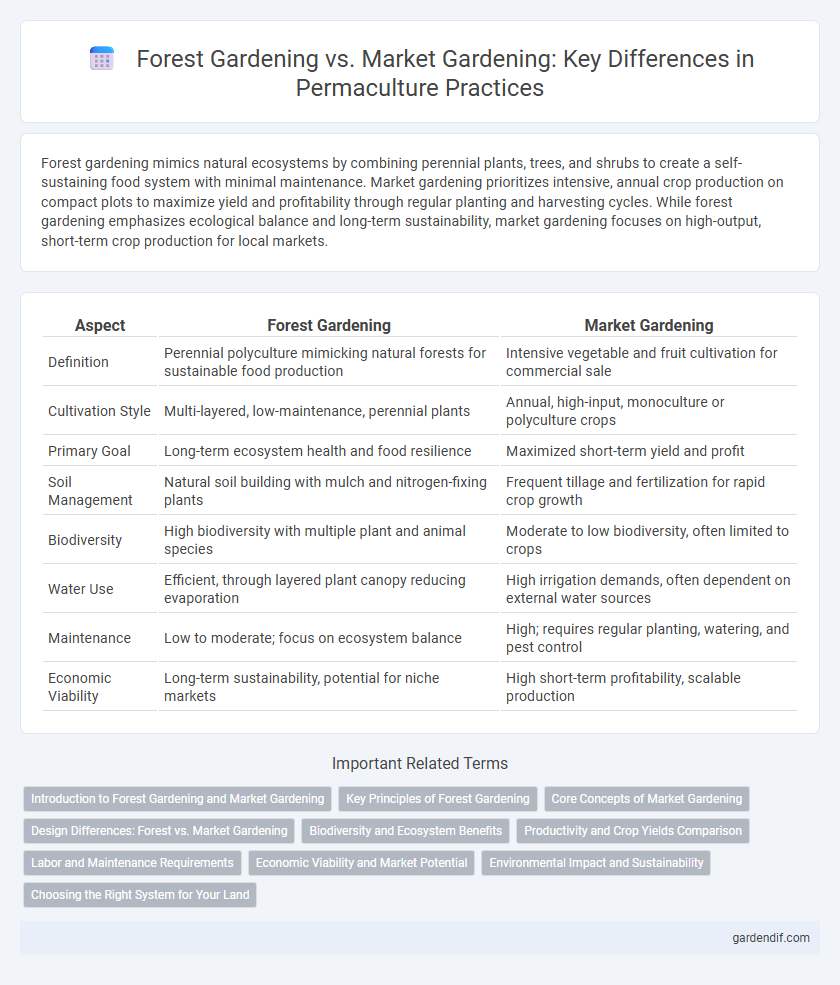
Forest Gardening vs Market Gardening Illustration
Forest gardening mimics natural ecosystems by combining perennial plants, trees, and shrubs to create a self-sustaining food system with minimal maintenance. Market gardening prioritizes intensive, annual crop production on compact plots to maximize yield and profitability through regular planting and harvesting cycles. While forest gardening emphasizes ecological balance and long-term sustainability, market gardening focuses on high-output, short-term crop production for local markets.
Table of Comparison
| Aspect | Forest Gardening | Market Gardening |
|---|---|---|
| Definition | Perennial polyculture mimicking natural forests for sustainable food production | Intensive vegetable and fruit cultivation for commercial sale |
| Cultivation Style | Multi-layered, low-maintenance, perennial plants | Annual, high-input, monoculture or polyculture crops |
| Primary Goal | Long-term ecosystem health and food resilience | Maximized short-term yield and profit |
| Soil Management | Natural soil building with mulch and nitrogen-fixing plants | Frequent tillage and fertilization for rapid crop growth |
| Biodiversity | High biodiversity with multiple plant and animal species | Moderate to low biodiversity, often limited to crops |
| Water Use | Efficient, through layered plant canopy reducing evaporation | High irrigation demands, often dependent on external water sources |
| Maintenance | Low to moderate; focus on ecosystem balance | High; requires regular planting, watering, and pest control |
| Economic Viability | Long-term sustainability, potential for niche markets | High short-term profitability, scalable production |
Introduction to Forest Gardening and Market Gardening
Forest gardening integrates diverse layers of perennial plants, trees, and shrubs to create a self-sustaining, resilient ecosystem mimicking natural forests while producing food. Market gardening emphasizes intensive, small-scale vegetable and fruit production on open, cultivated land aimed at high yields and quick market turnover. Both practices optimize space and resources but differ in plant diversity, temporal stability, and cultivation methods.
Key Principles of Forest Gardening
Forest gardening emphasizes perennial plants, biodiversity, and natural ecosystem functions to create resilient, self-sustaining food systems. Its key principles include multi-layered planting, minimal soil disturbance, and closed-loop nutrient cycles that mimic forest ecosystems. Unlike market gardening, which focuses on annual crops and intensive management, forest gardening promotes long-term sustainability through ecological harmony.
Core Concepts of Market Gardening
Market gardening emphasizes intensive cultivation of high-value vegetables and fruits on small plots, utilizing efficient crop rotation, succession planting, and soil fertility management to maximize yield per square foot. Core concepts include direct-to-consumer sales through farmers' markets and CSA programs, integrated pest management, and the use of season extension techniques like hoop houses to extend harvest periods. Unlike forest gardening's multi-layered perennial systems, market gardening focuses on annual crops with quick turnover to optimize profitability and productivity.
Design Differences: Forest vs. Market Gardening
Forest gardening emphasizes a multi-layered ecosystem design with perennial trees, shrubs, herbs, and ground covers that mimic natural forest structures to enhance biodiversity and soil health. Market gardening prioritizes intensive, annual crop production on cleared, well-drained plots optimized for high yields and efficient space utilization. The design differences highlight forest gardening's focus on long-term sustainability and ecological balance versus market gardening's focus on short-term productivity and crop rotation management.
Biodiversity and Ecosystem Benefits
Forest gardening enhances biodiversity by mimicking natural forest ecosystems, supporting diverse plant species, pollinators, and wildlife habitats through multilayered vegetation. Market gardening, while productive, typically involves monocultures or limited crop diversity, reducing ecological resilience and habitat variety. The complex, perennial structure of forest gardens promotes soil health, carbon sequestration, and natural pest regulation, delivering superior ecosystem benefits compared to conventional market gardening practices.
Productivity and Crop Yields Comparison
Forest gardening harnesses diverse, layered plant systems that mimic natural ecosystems, resulting in sustainable yields with low external inputs and high resilience over time. Market gardening typically emphasizes intensive seasonal cultivation on smaller plots, aiming for rapid, high-volume yields using fertilizers and irrigation. While market gardening can produce larger immediate harvests, forest gardening offers consistent, multi-year productivity with enhanced soil health and biodiversity benefits.
Labor and Maintenance Requirements
Forest gardening demands significantly less labor and maintenance due to its multi-layered, self-sustaining plant systems that mimic natural ecosystems. Market gardening requires intensive daily labor, including soil preparation, planting, weeding, irrigation, and pest control to maximize high-yield crop production. The perennial plantings in forest gardens reduce the need for frequent replanting and soil disturbance compared to the annual cycles of market gardens.
Economic Viability and Market Potential
Forest gardening emphasizes perennial plant systems with lower input costs and long-term yield stability, making it economically viable through sustainable resource use and reduced labor. Market gardening relies on intensive annual crop production with higher upfront costs and greater labor demands, but offers quicker market returns and more immediate cash flow. Both models have distinct market potentials: forest gardening targets niche markets for specialty and edible forest products, while market gardening suits conventional fresh produce markets with consistent demand.
Environmental Impact and Sustainability
Forest gardening enhances environmental sustainability by mimicking natural ecosystems, promoting biodiversity, improving soil health, and reducing the need for synthetic inputs. Market gardening, while intensive and productive on small plots, often relies on monocultures and frequent tilling, which can lead to soil degradation and increased carbon footprints. Incorporating perennial plants and diverse species in forest gardening supports carbon sequestration and long-term ecosystem resilience compared to the annual cycle of market gardening.
Choosing the Right System for Your Land
Forest gardening emphasizes diverse, perennial plant layers that mimic natural ecosystems, ideal for land requiring low maintenance and long-term sustainability. Market gardening focuses on intensive, seasonal cultivation of annual crops, maximizing short-term yields on smaller plots with high labor input. Selecting the right system depends on soil fertility, climate, labor availability, and your goals for productivity versus ecological resilience.
Forest Gardening vs Market Gardening Infographic

 gardendif.com
gardendif.com